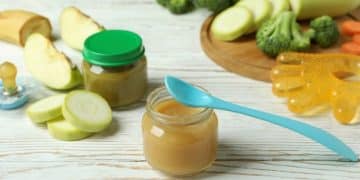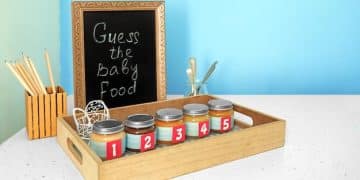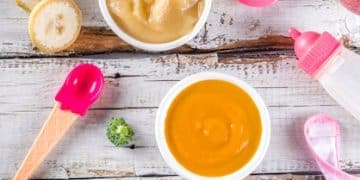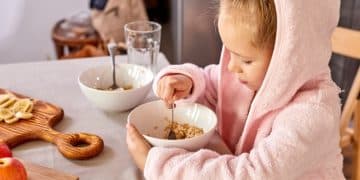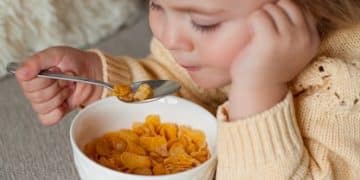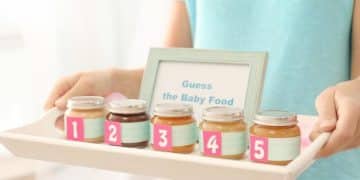Sustainable Baby Food Packaging: Eco-Friendly Choices for 2025
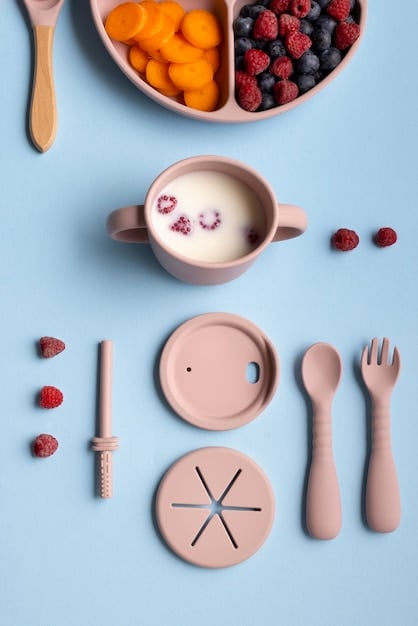
The Environmental Impact of Baby Food Packaging: Sustainable Feeding Choices for 2025 emphasizes the urgent need for eco-friendly packaging options in the baby food industry to reduce waste, protect the environment, and ensure a healthier future for children.
As parents, we want the best for our children, and that includes a healthy planet. The environmental impact of baby food packaging: sustainable feeding choices for 2025 is a critical issue, and understanding the challenges and solutions is essential for responsible parenting.
Understanding the Environmental Impact of Baby Food Packaging
Baby food packaging often relies on materials that contribute to pollution and resource depletion. Exploring the environmental footprint helps us appreciate the urgency of sustainable options.
The Problem with Traditional Packaging
Traditional baby food packaging often includes plastics and non-biodegradable materials. These materials can take hundreds of years to decompose, leading to significant environmental issues.
Furthermore, the manufacturing of these materials requires energy and resources. This contributes to carbon emissions and depletes natural resources.
- Plastic waste accumulating in landfills and oceans.
- Energy consumption during production.
- Depletion of natural resources like petroleum.
These factors highlight the unsustainable nature of traditional baby food packaging and the necessity for innovative, eco-friendly solutions.
Therefore, by understanding the drawbacks of conventional packaging, parents and manufacturers can make informed decisions that lessen their environmental impact.
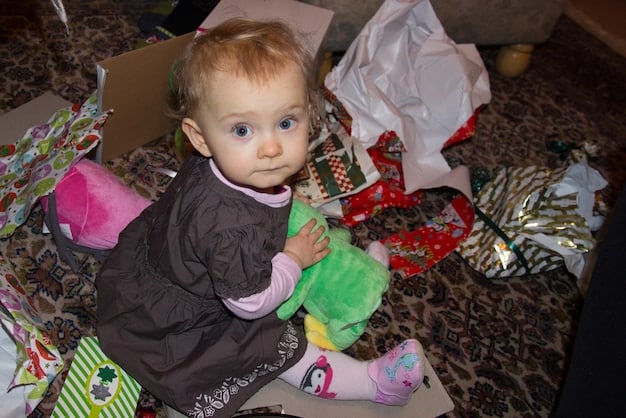
The Impact on Ecosystems
The environmental impact extends beyond just landfills. Plastic waste also finds its way into ecosystems, affecting wildlife and natural habitats.
Marine animals often ingest plastic, mistaking it for food. This can lead to starvation, poisoning, and other harmful effects.
- Plastic ingestion by marine animals.
- Habitat destruction due to pollution.
- Contamination of soil and water resources.
Addressing these ecological consequences requires a collective effort to promote sustainable packaging alternatives and reduce our reliance on traditional materials.
In conclusion, recognizing these issues is crucial for promoting responsible choices that safeguard our planet.
Benefits of Sustainable Baby Food Packaging
Sustainable baby food packaging offers numerous advantages, both for the environment and for your baby’s health. Exploring these benefits demonstrates why it’s a superior choice.
Reducing Carbon Footprint
Sustainable packaging options often have a lower carbon footprint compared to traditional packaging. This means they contribute less to greenhouse gas emissions and climate change.
Materials like plant-based plastics require less energy to produce and can even be composted after use, further reducing their environmental impact.
- Lower energy consumption during production.
- Reduced greenhouse gas emissions.
- Compostability and biodegradability.
By choosing sustainable packaging, you’re actively participating in efforts to mitigate climate change and protect the environment for future generations.
In brief, selecting sustainable options is a practical step that families can take toward reducing their carbon footprint.
Healthier for Your Baby
Many sustainable packaging options are made from materials that are free from harmful chemicals like BPA, phthalates, and PVC. These chemicals can leach into food and pose risks to your baby’s health.
Choosing baby food packaged in safer materials reduces your baby’s exposure to these toxins, supporting their healthy development.
- Absence of harmful chemicals like BPA and phthalates.
- Reduced risk of chemical leaching into food.
- Safer for your baby’s health and development.
Investing in sustainable packaging is therefore a direct investment in your child’s well-being.
Overall, prioritizing safety through responsible packaging choices is a crucial aspect of nurturing your child’s future health.
Types of Sustainable Baby Food Packaging for 2025
As we look ahead to 2025, several innovative and sustainable packaging options are emerging in the baby food industry. These alternatives offer a more eco-friendly approach to feeding your little one.
Compostable Pouches
Compostable pouches are an excellent alternative to traditional plastic pouches. They are made from plant-based materials that break down naturally in a composting environment.
These pouches reduce waste and can even enrich your garden soil, creating a closed-loop system.
- Made from plant-based materials.
- Breaks down naturally in compost.
- Reduces waste and can enrich soil.
Using compostable pouches is a simple yet effective way to reduce your environmental footprint.
In conclusion, opting for compostable pouches supports sustainable waste management practices.
Glass Jars
Glass jars are recyclable and reusable, making them a sustainable choice for baby food packaging. Glass is also inert, meaning it won’t leach chemicals into the food.
Many parents repurpose glass jars for storage or other household uses, further extending their lifespan.
- Recyclable and reusable.
- Does not leach harmful chemicals.
- Can be repurposed for storage.
Glass jars offer both environmental and health benefits, supporting a more sustainable lifestyle.
In essence, choosing glass jars combines practicality with environmental consciousness.

Reusable Silicone Pouches
Reusable silicone pouches are a versatile and eco-friendly option. They can be filled with homemade baby food, washed, and reused multiple times.
These pouches are durable, easy to clean, and help reduce single-use packaging waste significantly.
- Durable and reusable.
- Easy to clean.
- Reduces single-use packaging waste.
Investing in reusable silicone pouches is a practical way to minimize waste and save money in the long run.
Overall, incorporating reusable silicone pouches into your routine aligns with sustainable living practices.
How to Choose Sustainable Baby Food Packaging
Selecting sustainable baby food packaging involves considering several factors, from the materials used to the recyclability of the packaging. Here are some guidelines to help you make informed decisions.
Look for Certifications
Certifications like the Biodegradable Products Institute (BPI) or the Forest Stewardship Council (FSC) indicate that the packaging meets certain environmental standards.
These certifications provide assurance that the packaging is indeed sustainable and eco-friendly.
- Ensures compliance with environmental standards.
- Provides assurance of sustainability.
- Helps you identify eco-friendly products.
Always look for certifications when purchasing baby food to ensure you’re making a responsible choice.
In short, certifications serve as reliable indicators of environmental integrity.
Read Labels Carefully
Carefully examine the product labels to understand the type of packaging material used. Look for terms like “recyclable,” “compostable,” or “plant-based.”
Understanding the material composition enables you to make informed decisions aligned with your sustainability goals.
- Identifies the packaging material.
- Helps you understand recyclability.
- Supports informed purchasing decisions.
Take the time to read the labels and educate yourself about different packaging materials.
In essence, informed decision-making begins with a thorough understanding of product labels.
Support Brands Committed to Sustainability
Choose brands that prioritize sustainability and environmental responsibility. These companies are more likely to use eco-friendly packaging and implement sustainable practices throughout their operations.
Supporting these brands encourages the industry to adopt more sustainable practices.
- Encourages industry-wide sustainability.
- Promotes eco-friendly practices.
- Rewards responsible companies.
By supporting brands committed to sustainability, you’re voting with your dollars for a healthier planet.
Overall, aligning your purchasing decisions with sustainable values fosters positive change.
The Role of Parents in Promoting Sustainable Feeding
Parents play a crucial role in promoting sustainable feeding practices. By making conscious choices and advocating for change, you can contribute to a healthier future for your children and the planet.
Educate Yourself and Others
Learn about the environmental impact of baby food packaging and share your knowledge with other parents. The more people are aware of the issue, the more likely they are to make sustainable choices.
Spreading awareness is a powerful tool for driving change and fostering a culture of sustainability.
- Increases public awareness.
- Encourages informed decision-making.
- Promotes a culture of sustainability.
Education is the first step toward creating a more sustainable world for our children.
In essence, knowledge empowers parents to make environmentally sound choices.
Advocate for Change
Support policies that promote sustainable packaging and hold manufacturers accountable for their environmental impact. Contact your elected officials and let them know that you value sustainability.
Advocating for change can influence regulations and drive industry-wide improvements.
- Influences regulations and policies.
- Holds manufacturers accountable.
- Drives industry-wide improvements.
Your voice matters, and you can make a difference by advocating for sustainable policies.
Overall, collective action is essential for achieving meaningful and lasting change.
Embrace DIY Baby Food
Making your own baby food allows you to control the ingredients and packaging. You can use fresh, local produce and store the food in reusable containers.
DIY baby food reduces waste and ensures that your baby is getting the healthiest possible food.
- Reduces waste and controls packaging.
- Ensures fresh and healthy ingredients.
- Supports local farmers and producers.
Embracing DIY baby food is a practical and sustainable way to nourish your child.
In conclusion, creating homemade baby food supports both your baby’s health and the environment.
Future Trends in Sustainable Baby Food Packaging
Looking ahead, the future of baby food packaging is likely to be shaped by ongoing innovations and increasing consumer demand for sustainable options. Here are some trends to watch for.
Bioplastics and Renewable Materials
Bioplastics made from renewable resources like cornstarch and sugarcane are gaining popularity. These materials are biodegradable and compostable, offering a more sustainable alternative to traditional plastics.
Innovation in this area will likely lead to even more eco-friendly packaging options in the future.
- Biodegradable and compostable.
- Made from renewable resources.
- Reduces reliance on fossil fuels.
Bioplastics represent a significant step toward a more sustainable future for baby food packaging.
In essence, embracing bioplastics aligns with a circular economy model.
Minimalist Packaging Designs
Minimalist packaging designs that use less material and reduce waste are becoming more common. These designs focus on functionality and sustainability without unnecessary frills.
Reducing the amount of packaging material required can significantly lessen the environmental impact.
- Uses less material.
- Reduces waste.
- Focuses on functionality.
Minimalist packaging offers an elegant solution to the problem of excessive waste.
Overall, simpler designs are better for the environment and just as effective.
Innovative Recycling Programs
Innovative recycling programs that make it easier for consumers to recycle baby food packaging are emerging. These programs may involve partnerships between manufacturers, retailers, and local governments.
Improving recycling infrastructure and accessibility is essential for achieving a truly circular economy.
- Improves recycling rates.
- Facilitates a circular economy.
- Promotes collaboration and partnership.
These programs make it easier for parents to recycle baby food packaging responsibly.
In conclusion, enhanced recycling programs are crucial for closing the loop and minimizing waste.
| Key Point | Brief Description |
|---|---|
| 🌱 Eco-Friendly Packaging | Choose compostable, recyclable, or reusable baby food packaging. |
| ♻️ Recycling Initiatives | Support brands and programs that enhance baby food packaging recycling. |
| 🌿 DIY Baby Food | Make homemade baby food to control ingredients and packaging waste. |
| 📚 Educate Others | Spread awareness about sustainable baby feeding practices. |
Frequently Asked Questions
▼
The primary concern is that traditional baby food packaging often uses non-biodegradable materials, contributing to pollution and environmental degradation.
▼
Look for certifications like BPI or FSC on the packaging, indicating it meets environmental standards. Also, check labels for terms like “recyclable” or “compostable.”
▼
Sustainable alternatives include compostable pouches made from plant-based materials, glass jars that are recyclable, and reusable silicone pouches.
▼
Supporting these brands encourage more eco-friendly packaging and operations in the industry while rewarding companies committed to reducing their environmental impact.
▼
Parents can educate themselves and others, advocate for change, support sustainable brands, and choose DIY baby food options to champion eco-friendly feeding practices.
Conclusion
Choosing sustainable baby food packaging is a small change that can make a big difference. By understanding the environmental impact of baby food packaging and making informed choices, we can create a healthier planet for our children and future generations.
